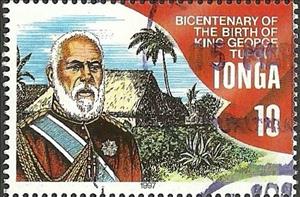Stamp: Bicentenary of the birth of King George Tupou I (Tonga 1997)
Bicentenary of the birth of King George Tupou I (Tonga 1997)
28 April (Tonga ) within release 200th anniversary of King George Tupou I and Christianity goes into circulation Stamp Bicentenary of the birth of King George Tupou I face value 10 Tongan seniti
| Stamp Bicentenary of the birth of King George Tupou I in catalogues | |
|---|---|
| Michel: | Mi: TO 1468 |
| Stamp Number: | Sn: TO 958 |
Stamp is horizontal format.
Also in the issue 200th anniversary of King George Tupou I and Christianity:
- Stamp - Arrival of the missionary ship the Duff face value 10;
- Stamp - Bicentenary of the birth of King George Tupou I face value 10;
- Stamp - Arrival of the missionary ship the Duff face value 10;
- Se-tenant - King Tupou I face value 3*60;
- Se-tenant - King Tupou I face value 3*80;
- Stamp - Arrival of the missionary ship the Duff face value 60;
- Stamp - Arrival of the missionary ship the Duff face value 80;
- Stamp - Missionaries and Tongans face value 60;
- Stamp - Missionaries and Tongans face value 80;
- Stamp - Missionaries Landing on Tongatapu face value 60;
- Stamp - Missionaries Landing on Tongatapu face value 80;
- Mini Sheet - 200th Anniversary of King George Tupou I and Christianity face value 6*10;
Stamp Bicentenary of the birth of King George Tupou I it reflects the thematic directions:
A house is a single-unit residential building. It may range in complexity from a rudimentary hut to a complex structure of wood, masonry, concrete or other material, outfitted with plumbing, electrical, and heating, ventilation, and air conditioning systems. Houses use a range of different roofing systems to keep precipitation such as rain from getting into the dwelling space. Houses generally have doors or locks to secure the dwelling space and protect its inhabitants and contents from burglars or other trespassers. Most conventional modern houses in Western cultures will contain one or more bedrooms and bathrooms, a kitchen or cooking area, and a living room. A house may have a separate dining room, or the eating area may be integrated into the kitchen or another room. Some large houses in North America have a recreation room. In traditional agriculture-oriented societies, domestic animals such as chickens or larger livestock (like cattle) may share part of the house with humans.
King is the title given to a male monarch in a variety of contexts. The female equivalent is queen regnant (while the title of queen on its own usually refers to the consort of a king). In the context of prehistory, antiquity and contemporary indigenous peoples, the title may refer to tribal kingship. Germanic kingship is cognate with Indo-European traditions of tribal rulership (c.f. Indic rājan, Gothic reiks, and Old Irish rí, etc.) In the context of classical antiquity, king may translate Latin rex or either Greek archon or basileus. In classical European feudalism, the title of king as the ruler of a kingdom is understood as the highest rank in the feudal order, potentially subject, at least nominally, only to an emperor (harking back to the client kings of the Roman Empire). In a modern context, the title may refer to the ruler of one of a number of modern monarchies (either absolute or constitutional). The title of king is used alongside other titles for monarchs, in the West prince, emperor, archduke, duke or grand duke, in the Middle East sultan or emir; etc. Kings, like other royalty, tend to wear purple because purple was an expensive color to wear in the past.
The Arecaceae is a family of perennial, flowering plants in the monocot order Arecales. Their growth form can be climbers, shrubs, tree-like and stemless plants, all commonly known as palms. Those having a tree-like form are called palm trees. Currently, 181 genera with around 2,600 species are known,
most of which are restricted to tropical and subtropical climates. Most palms are distinguished by their large, compound, evergreen leaves, known as fronds, arranged at the top of an unbranched stem, except for the Hyphaene genus, who has branched palms. However, palms exhibit an enormous diversity in physical characteristics and inhabit nearly every type of habitat within their range, from rainforests to deserts.



